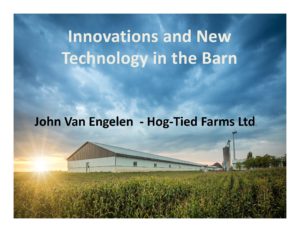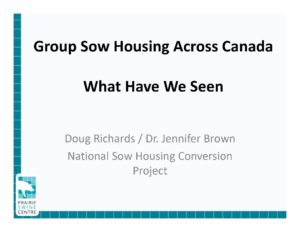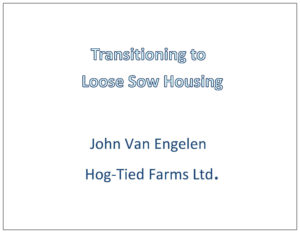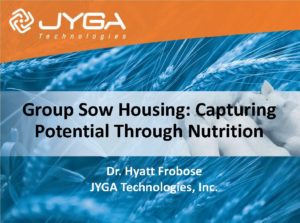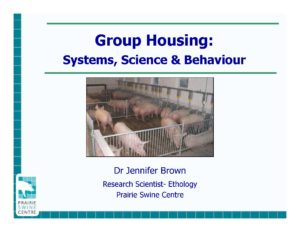Demonstrating Management Practices that Enhance the Sustainability of Pork Production
Posted in: Pork Insight Articles, Prairie Swine Centre, Swine Innovation by admin on November 7, 2017 | No Comments
Demonstrating Management Practices that Enhance the Sustainability of Pork Production
Activity 1.1 – Successfully Converting to Gestating Sow Group Housing
Innovation to Adoption: On Farm Demonstration of Swine Research
Posted in: Pork Insight Articles, Prairie Swine Centre, Swine Innovation by admin on | No Comments

From Innovation to Adoption: On-Farm Demonstration of Swine Research is an integrated collaborative project involving Swine Innovation Porc, Centre de développement du porc du Québec and Prairie Swine Centre. This project will help the 7,000 pork producers across Canada seize new opportunities and incorporate novel technologies and strategies in their production systems. Specifically, this project involves three primary components:
- Partner with commercial pork producers/organizations to serve as Lead-Users (demonstration sites) for the new technology or management practice;
- Communicate results and information gathered through the demonstration sites to others within the Canadian pork industry increasing the adoption of new technologies and management practices throughout Canada.
- Develop tools to increase the speed of adoption of new technologies and strategies on pig farms
ACTIVITY 1. Demonstrating Management Practices that Enhance the Sustainability of Pork Production
Objective: Identify efficiencies in transitioning gestation sows from stalls to group housing systems through early adopters and science.
1.1 Successfully Converting to Gestating Sow Group Housing
1.2 Environmental Enrichment Strategies
1.2 Improved Laying Areas for Sows
1.3 Reducing Water Consumption in Swine Barns
ACTIVITY 2. Demonstrating New Nutritional Strategies – Low Cost Feeding Strategies for Sows
Objective: Demonstrate low cost feeding strategies for optimum sow productivity
2.1 Low Cost Feeding Strategies for Sows
ACTIVITY 3. Auditing On-Farm Best Management Practices
Objective: Measure the pork industry’s adoption of best management practices that reduce cost of production, enhance sustainability and reduce labour commitments.
ACTIVITY 4. Swine Health Management an Biosecurity – Rapid Assessment of Transport Trailer Cleanliness
Objective: Demonstrate the use of ATP bioluminescence meter for rapid assessment of surface cleanliness of swine transport trailers.
ACTIVITY 5. Communications
Objective: Increase the speed of technology of adoption of Lead-User activities by communicating demonstration results to the Canadian pork industry.
| This project ‘From Innovation to Adoption: On-Farm Demonstration of Swine Research’ is funded by Swine Innovation Porc within the Swine Cluster 2: Driving Results Through Innovation research program. Funding is provided by Agriculture and Agri‐Food Canada through the AgriInnovation Program, provincial producer organizations and industry partners. | 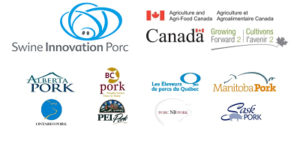 |
Water Intake Checklist
Posted in: Pork Insight Articles, Prairie Swine Centre by admin on October 27, 2017 | No Comments
EUTHANASIA – CODE OF PRACTICE FOR THE CARE AND HANDLING OF PIGS
Posted in: Prairie Swine Centre, Swine Innovation, Welfare by admin on October 26, 2017 | No Comments
The following is a list of acceptable and unacceptable methods of euthanasia of individual animals for
use on-farm, as well as methods that are only considered acceptable with the noted conditions. The
chart is based on the information that was available at the time of publishing1. For any method to be
considered acceptable, it must render the animal immediately insensible and the animal must not return
to sensibility prior to death. Individuals who euthanize pigs must be trained in the appropriate methods.
Identification, treatment and prevention of shoulder lesions in sows
Posted in: Pork Insight Articles, Prairie Swine Centre by admin on October 24, 2017 | No Comments
Shoulder lesions are most commonly observed in sows during the weeks following farrowing. Long periods of lying combined with poor body condition can increase the likelihood of sows developing shoulder sores. The prevalence of shoulder lesions varies greatly depending on farm and sow factors, with anywhere from 10 to 50% of sows being affected. Shoulder lesions, also referred to as shoulder sores or ulcers, typically appear as a circular sore on the upper shoulder.
In sows, shoulder lesions appear over the scapula, where the amount of soft tissue between the skin and bone is insufficient to distribute external pressure. Lying laterally (such as during nursing bouts) puts pressure on this area, and prolonged lying can restrict blood flow and result in localized tissue damage. Shoulder lesions in sows are comparable with pressure ulcers in humans, also known as bed sores. Once they have developed they are difficult to treat, and will often return during the next lactation. In practical terms this means sows are at their highest risk for developing lesions in the weeks after farrowing as they can spend over 90% of their time lying during this period.
The first indication of a shoulder lesion forming is reddening of the skin. The skin may become damp and flies can be attracted to the area. If the problem goes untreated, the sore can quickly progress to an open ulcer, and in extreme cases, the underlying bone may be exposed. The occurrence and severity of shoulder lesions varies greatly from farm-to-farm, reflecting the multifactorial nature of this problem.
Investigating ventilation system requirements for a sow gestation barn converted to group housing
Posted in: Pork Insight Articles, Prairie Swine Centre by admin on October 2, 2017 | No Comments
Computer simulation was utilized to assess the performance of different ventilation system configurations needed for a sow gestation barn newly-converted to group housing. Various configurations of the ventilation system involving varying capacities and locations of exhaust fans as well as size, design and location of air inlets, were examined based on indoor air quality (i.e., air temperature, humidity, and air speed at the animal level) and ventilation effectiveness (i.e., air distribution and airflow pattern, inlet air velocity, and room static pressure). Based on the computer simulation results, horizontal flow ventilation system with air inlets on one side and exhaust fans on the opposite side showed the best simulated performance among all ventilation design configurations tested. The horizontal flow ventilation configuration was then selected for further evaluation in an actual group sow housing facility, where energy use, temperature and air quality, and sow welfare and performance were assessed.
Protecting What You Have
Posted in: Pork Insight Articles, Prairie Swine Centre, Press Releases by admin on September 15, 2017 | No Comments
The reminders of the spread of PEDv across Manitoba the past 5 months remind us just how fragile our systems can be to external challenges. Current market prices and forward contracts have given us a well needed breather as an industry to rebuild/refurbish our farms and fix balance sheets. Is that current financial success holding us back?
What I mean – Are we taking threats seriously enough to actually change practices to protect our farms? This article is primarily health focused because we have had the opportunity to travel to many farms, conferences, open houses etc. the past 6 months and there is a disturbing complacency toward health threats emerging in our attitudes and practices in spite of the real threat PEDv represents. If you are reading this in southern Manitoba you are probably thinking that health is all we have thought about for months and yes we have changed and reviewed practices and everyone is on ‘high alert’. My concern is that outside of Manitoba we are not taking the same heightened awareness.
Two specific incidents come to mind. A packing plant tour is an excellent way to stay informed of how our product is transformed into food, this is particularly important for the students and staff at Prairie Swine Centre to help understand the larger industry. In 2014, several months after PEDv began wreaking havoc in the US, I was on a similar tour and everyone arrived with cleaned vehicles and were putting on plastic boot covers before they stepped out of their vehicle – in 2017 it was back to business as usual, farm vehicles in various states of cleanliness and not one pair of plastic boot covers to be seen. A second example was at a swine industry tradeshow, tractor trailers and goosenecks parked in the lot beside the passenger vehicles. It was not difficult to tell these trailers were swept out but not washed nor baked.
These two examples speak to my concern that we just aren’t using all the knowledge available to us to protect our farms.
At the same time I see headlines that tell us health challenges are all around us. Internationally Uruguay has identified PRRS for the first time in widely separated areas. The country undergoes regular testing so what happened? Closer to home, a PRRS virus variant previously associated with Minnesota is now in western Canada. Homegrown problems with Strep Suis seem to be on the rise. The Canada-West Swine Health Intelligence Network noted laboratories reporting an increase in positive cultures. Our own experience is that hot temperatures and extra movement and handling triggered a couple weeks of sudden losses that are not typical for this herd.
Our industry has enjoyed phenomenal growth in productivity and generally improving health status for several years. We know all too well that we cannot rely on continued access to antibiotics, and now additional scrutiny on zinc and previously copper in the EU promises to spill over and take yet one more tool from the troubleshooting toolbox. One editorial suggested 2.50 Euro per pig in reduced earning if Zinc Oxide became unavailable. These factors are all the more reason to keep the biosecurity high.
The following is sourced from the Canada-West Swine Health Intelligence Network Report July 31 regarding heightened biosecurity measures that should be considered as you review your biosecurity plan.
- Managing Transport –wash and bake trucks
- Managing any supplies, including feed ingredients and breeding stock coming from infected areas
- Compost deadstock (to reduce rendering traffic to your farm)
- Follow strict contractor protocols
- Participate in the environmental testing programs
Our Centre is undergoing another internal biosecurity audit. We do this about every 18 months to 2 years, rotating between internal and external audits. Every time we find something. This is time well spent to protect what we have.
Using creep feeding as a strategy to improve post weaning feed intake and piglet growth
Posted in: Nutrition, Pork Insight Articles, Prairie Swine Centre, Press Releases by admin on September 5, 2017 | No Comments
Overall, the provision of creep feed for 5 days prior to weaning had no effect on weaning weights or growth rate from day 21 to weaning, however, modest effects were observed on piglet growth rate in the nursery. Interestingly, within the creep treatment, it was the lighter piglets which took advantage of the creep feed, and this subset of piglets showed an improved growth rate. Therefore, the provision of creep feed in the farrowing room provides benefits to piglets that show evidence of consumption and it is the lighter-weight piglets which benefit most from the provision of creep feed, and thus within litter variability may be reduced.
Recommended Flow Rate & Height of Nipple Drinkers
Posted in: Pork Insight Articles, Prairie Swine Centre, Press Releases, Swine Innovation by admin on August 24, 2017 | No Comments
Science of Ethology
Posted in: Pork Insight Articles, Prairie Swine Centre, Press Releases, Welfare by admin on August 8, 2017 | No Comments
 The field of Animal Science experienced an expansion of its goals during and subsequent to the 1960s. Much of this shift could be explained by concern over the intensive production practices that had developed. In addition to the goals of productivity and efficiency, issues such as food safety, environmental protection, and animal welfare became issues for the public, and therefore the producer. Animal agriculture not only had to be efficient, but it had to be carried out in a socially conscious manner. Just as productivity and efficiency involved several disciplines, the new goals (impact on behavior and welfare) were also best addressed in a multi-disciplinary manner, including several new ones.not sure about this, can we be more specific?
The field of Animal Science experienced an expansion of its goals during and subsequent to the 1960s. Much of this shift could be explained by concern over the intensive production practices that had developed. In addition to the goals of productivity and efficiency, issues such as food safety, environmental protection, and animal welfare became issues for the public, and therefore the producer. Animal agriculture not only had to be efficient, but it had to be carried out in a socially conscious manner. Just as productivity and efficiency involved several disciplines, the new goals (impact on behavior and welfare) were also best addressed in a multi-disciplinary manner, including several new ones.not sure about this, can we be more specific?
Ethology, or the study of animal behaviour, has had a role during both eras of Animal Science. As the discipline developed within biology in the mid-twentieth century, its applied component studied means to improve productivity in farm animals. Although a relatively minor discipline of the day, its contribution to animal productivity included reproductive, maternal, social and feeding behaviours as well as environmental control. There were few scientists in applied ethology. In the 1970s only three Canadian universities had agricultural faculty for whom behaviour could be called their primary discipline.
With greater emphasis on social concerns, ethology took on an expanded role, particularly in the area of animal care and welfare. This goal is still multi-disciplinary (see chapter on Animal Welfare Science), but ethology has been the most widely recognized of those disciplines. Much of the work has been to determine how well an animal can adapt to its production environment. In meeting this need for welfare assessment the discipline of ‘applied ethology’ has to some degree become the discipline of ‘welfare science’. Many of its scientists have become proficient, through personal training or collaboration, in disciplines such as stress physiology, immunology and environmental management.
However, the discipline also retains a strong production component. As consumers demand a change in production practices, ethology joins with other disciplines in finding ways to produce efficiently under the new standards. As an example, prod-free handling has become the standard for most situations in the pig industry for reasons of both welfare and meat quality. Ethology has contributed to this transition in management through facility design, handling methods, and training of personnel.
The bulk of this publication is on sow housing and management. Once the industry within a country decides to move to group housing, the role of ethology has been to develop facilities and management methods to ensure efficient production within those systems. Thus we now talk of grouping strategies, mixing vs feeding based aggression, and competitive vs non-competitive systems. All of these are based on behavioural principles.










